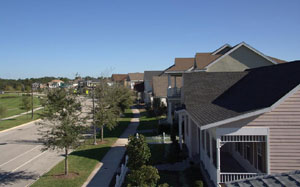
Walkable Communities
Harmony was designed as a walkable community, but it is up to you to take advantage of the many opportunities to leave your car behind and use your feet. The idea behind these communities is to promote alternative modes of transportation, such as walking and biking. The benefits are not only for human health, but you save energy and money from less use of your car!
- Traditional Neighborhood Design
- Walking and Biking in Harmony
- Why is Walking and Biking Important to Me?
- Neighborhood Electric Vehicles
Traditional Neighborhood Design
Walkable communities are often called traditional neighborhoods. In Traditional Neighborhood Design (TND) communities such as Harmony, a number of features make for a more walkable environment. Here are a few examples that you’ll recognize:
Alleys permit narrower lots with fewer driveways on local streets. Fewer driveways mean more affordable, smaller home sites and more space for on-street parking, especially if the home-owners use the alleys for their own vehicular access, parking, and utilitarian activities. Alleys provide space for underground utilities while freeing streets for trees and other plantings. Alleys also can be used for trash collection, mail delivery and emergency vehicle access. TND projects do not have alleys everywhere, but where they do, traffic safety may improve. Alleys eliminate driveways and the need for backing into the street, which would otherwise occur and is inherently unsafe.
Compact Neighborhoods provide smaller house lots and denser commercial areas which are important to pedestrians in at least two ways: 1. More people can travel shorter distances to meet their daily travel needs. 2. More green space can be kept in larger areas to provide a greener community and healthier wildlife populations.
Front Porches are also pedestrian oriented features. Porches provide a semi-private space from where you can greet passers by from the comfort of your home - and maybe even invite them up for some iced tea!
Bike Lanes are featured on Harmony’s busier streets and provide a safe area for cyclists. If you’re driving or parking a car, stay out of these lanes. Bicyclists have the same right to travel on the streets as do motorists. In fact, it is safer for everyone for an experienced bicyclist to ride in the street than on a sidewalk.
Trails, Paths, and Sidewalks are prominent in Harmony, encouraging people to walk. These connections allow people to walk from one neighborhood to the next and to the town center. One significant connection is under state road 192 where children can walk to school. In addition, there are a number of nature trails where people can exercise and view local wildlife and habitats.

Walking and Biking in Harmony
Walking and biking in Harmony allows one to enjoy the outdoors, see wildlife, and get exercise. Several constructed nature trails are available on the property. In addition, people can ride horses on a few of these trails. Trail use is only during the daylight hours between 1/2 hour after sunrise and 1/2 hour before sunset. Please respect any trail closures and other trail advisory signs. See Harmony trail map for locations of walking, biking, and horseback riding trails.
Trail Etiquette
- Cyclists yield to horses and hikers, all yield to horses.
- Keep the trail clean
- Please carry your trash out
- Keep pets under control
- Dogs welcome, but keep pets on a short leash
- Trail passes through cattle pasture
- Close and latch all gates
- Do not feed wildlife
- Enjoy animals from a distance
- Generally people should stay on trails to avoid injury and damage to habitat, especially where the trails pass through lands preserved because of their natural values.
Equestrians
Warning: Under Florida law, an equine activity sponsor, or equine professional is not liable for an injury to, or the death of, a participant in equine activities resulting from the inherent risks of equine activities.
- Horse riding limited to Harmony residents and accompanied guests
- Before riding, please register at the Sales & information Gallery
- Protect yourself and others
- Riders of all ages to wear a helmet
- Do not wear headphones on the trail
- Equestrians may not bring dogs.

Safe Bicycling Tips
- When turning or stopping, always use hand signals.
- Look both ways at street corners and driveways.
- Always ride to the right, with the traffic.
- Always stop at STOP signs and the curb.
- When you ride on the sidewalk, watch out for people.
- Wear a helmet! Your head may be your most valuable asset.

Why is Walking and Biking Important to Me?
Increased levels of bicycling and walking can result in significant benefits in terms of health and physical fitness, the environment, and improved transportation. Research has shown that even low to moderate levels of exercise, such as regular bicycling or walking, can reduce the risk of coronary heart disease, stroke, and other chronic diseases; help reduce health care costs; contribute to greater functional independence in later years of life; and improve quality of life at every stage. Studies show that these benefits far outweigh any possible negative effects in life-years lost from injuries or fatalities. Replacing automobile trips with non-motorized and non-polluting bicycling or walking trips is good for the environment. The savings from reduced pollution, oil importation, and congestion costs alone can be 50 cents or more for every automobile-mile displaced by bicycling or walking. As the price of gas rises, this savings goes up with it. In terms of reducing contributions to global climate change, the savings may be priceless.
Auto exhaust also causes increases in ozone and carbon dioxide in our air. This is a health concern for central Floridians. Every pedestrian trip that you take avoids contributing to these pollution concerns.
Given these many benefits, it is not surprising that a 2005 Seattle, WA study found that a community with a mix of uses - homes with offices, shops, schools, parks, and other destinations - matters most when it comes to transportation efficiency. Studies such as these can help show what action communities might take to further their goals of reducing auto dependency, increasing transportation choice and efficiency, and improving air quality and residents health.


Neighborhood Electric Vehicles
As a pedestrian friendly community, Harmony supports alternatives to traditional motor vehicle use for getting around town. One of these options includes the use of Neighborhood Electric Vehicles (NEV). Though many of us are familiar with electric golf carts, NEVs are much more than that. NEVs are electrically powered, light vehicles, and are street legal on roads with a limit of 35 m.p.h. or below. Golf carts are not. NEVs require a license plate and Florida registration just like a car and have the basic lights, mirrors, seat belts and horn that a car would have. They can be driven on any of the public streets of Harmony, but are not allowed on US 192 because of the increased speed limit.
As electric vehicles, NEVs are operated by a bank of batteries carried on board. To recharge, they plug into a standard household 110-volt outlet and with that should be able to carry you around town for all of your daily needs without having to be recharged until you get home at the end of the day. With a top speed of 20 – 25 miles per hour and options available to include additional cargo storage or canvas curtains to keep rain out, these vehicles provide a viable alternative for in town driving needs throughout the year. The electric powertrain means that the usual maintenance of traditional motor vehicles, such as oil changes, adding coolant to prevent overheating, adjusting spark plugs, etc. aren’t needed.
Perhaps the most popular NEV is the GEM line introduced by Chrysler Motors. GEM has offered a cost comparison of owning a GEM NEV versus the cost of keeping a gas powered vehicle for neighborhood use.
Customers around the world are discovering how affordable and cost-effective it is to own and operate a GEM battery-electric vehicle. Discover how much you can save by owning a GEM car!
| Owning a GEM Vehicle* | |
| $7,500 | Vehicle Cost |
| $900.00 | Insurance |
| $90.00 | Electricity |
| Electricity | Subtotal |
| ($4,000) | Residual |
| Residual | Total |
| *Estimated cost of ownership based on a GEM e2 base model vehicle over a three-year period, driving 3,600 miles. Average cost based on independent research. | |
| Owning a Gasoline-Powered Vehicle* | |
| $20,000.00 | Vehicle Cost |
| $3,000.00 | Insurance |
| $450.00 | Fuel |
| $120.00 | Maintenance** |
| $23,570.00 | Subtotal |
| ($10,000.00) | Residual |
| $13,570.00 | Total |
| *Estimated cost of ownership over a three-year period, driving 3,600 miles. Average cost based on independent research. | |
| **Average cost based on manufacturer's recommended maintenance schedule. | |
Source: http://www.gemcar.com/affordability/default.asp?ID=355; 12/21/09.
The U.S. department of Energy maintains a website of current rebates and incentives offered by the federal and state governments to encourage the use of alternative energy vehicles: http://www.afdc.energy.gov/afdc/incentives_laws.html
The community of Celebration, also in Osceola County has promoted NEV use for some time. As a result, NEVs may be purchased and maintained through businesses located in that area. They can also be purchased locally from selected central Florida Chrysler dealers.

